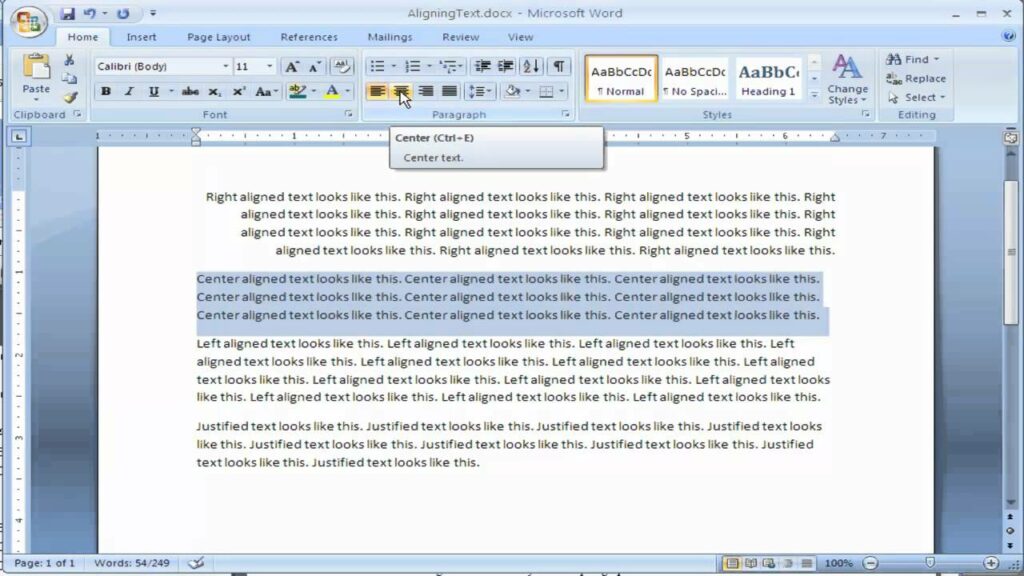Mastering Text Alignment in Microsoft Word: A Comprehensive Guide

Introduction: Text alignment is a fundamental aspect of document formatting in Microsoft Word. Whether you’re drafting a report, creating a resume, or designing a brochure, mastering the art of text alignment can greatly enhance the readability and visual appeal of your documents. In this comprehensive guide, we’ll explore the techniques, tips, and tricks for aligning text in Microsoft Word like a pro. From basic alignment options to advanced formatting features, this guide will equip you with the knowledge and skills to create polished and professional-looking documents that effectively convey your message.
Understanding Text Alignment: Before we delve into the application process, let’s understand what text alignment is and how it affects the layout of your document:
- What is Text Alignment?
- Text alignment refers to the horizontal positioning of text within a document or text box.
- There are four primary text alignment options in Microsoft Word: left-aligned, center-aligned, right-aligned, and justified.
- Each alignment option has its own unique characteristics and visual impact on the layout of the document.
- Text Alignment Options:
- Left-Aligned: In left-aligned text, the text is aligned along the left margin, creating a straight edge on the right side.
- Center-Aligned: In center-aligned text, the text is centered horizontally between the left and right margins, creating an even appearance on both sides.
- Right-Aligned: In right-aligned text, the text is aligned along the right margin, creating a straight edge on the left side.
- Justified: In justified text, the spacing between words is adjusted so that both the left and right edges of the text are aligned with the margins, creating a straight edge on both sides.
- Effects of Text Alignment:
- Text alignment affects the visual flow and readability of the document, as well as the overall appearance and design.
- Different alignment options may be used to achieve specific formatting goals or to create emphasis or hierarchy within the document.
Now that you understand the basics of text alignment, let’s explore how to align text in Microsoft Word.
Step-by-Step Guide to Aligning Text: Follow these steps to align text in Microsoft Word:
- Open your Document:
- Launch Microsoft Word and open the document where you want to align the text.
- Select Text:
- Click and drag your mouse to select the text that you want to align.
- Alternatively, you can place the cursor at the beginning of the text and hold down the “Shift” key while using the arrow keys to select the text.
- Choose Alignment Option:
- With the text selected, navigate to the “Home” tab in the top menu bar.
- In the “Paragraph” group, you’ll find the alignment buttons: “Align Left,” “Center,” “Align Right,” and “Justify.”
- Click on the desired alignment button to apply the alignment to the selected text.
- Left-Align Text:
- Click on the “Align Left” button to align the text along the left margin.
- This option is commonly used for body text and paragraphs, as it creates a clean and consistent left edge.
- Center-Align Text:
- Click on the “Center” button to center-align the text horizontally between the left and right margins.
- This option is useful for creating titles, headings, or other text elements that you want to appear centered on the page.
- Right-Align Text:
- Click on the “Align Right” button to align the text along the right margin.
- This option is often used for aligning text such as dates, numbers, or signatures along the right edge of the page.
- Justify Text:
- Click on the “Justify” button to justify-align the text, adjusting the spacing between words to create straight edges on both the left and right sides.
- This option is commonly used for creating a clean and polished appearance in documents with narrow columns or justified text blocks.
- Adjust Line Spacing (Optional):
- Depending on the alignment option you choose, you may need to adjust the line spacing to optimize the appearance of the text.
- You can adjust the line spacing using the “Line and Paragraph Spacing” options in the “Paragraph” group on the “Home” tab.
- Apply Alignment to Entire Paragraph:
- If you want to apply the alignment to an entire paragraph, simply place the cursor anywhere within the paragraph and click on the desired alignment button.
- Word will automatically apply the alignment to the entire paragraph, including any new text you type within the paragraph.
Tips for Effective Text Alignment: Here are some additional tips for effectively aligning text in Microsoft Word:
- Use Alignment Consistently:
- Maintain consistent alignment throughout your document to create a cohesive and professional appearance.
- Choose one alignment option for body text and stick with it to avoid visual clutter and inconsistency.
- Consider Visual Hierarchy:
- Use alignment to create visual hierarchy and emphasis within your document.
- For example, center-align headings or titles to make them stand out, while left-aligning body text for readability.
- Be Mindful of Readability:
- Consider the readability of your document when choosing alignment options.
- Left-aligned text is generally easier to read, especially for longer passages, as it creates a consistent left edge for the eye to follow.
- Use Justification Sparingly:
- Use justified text sparingly, as excessive justification can create uneven spacing and awkward word breaks.
- Reserve justified alignment for narrow columns or blocks of text where it enhances the appearance and readability of the document.
- Review Alignment in Different Views:
- Before finalizing your document, review the alignment in different views, such as Print Layout, Web Layout, or Draft, to ensure that it appears as intended.
- Make any necessary adjustments to the alignment to optimize the appearance and readability of the document in each view.
Conclusion: Text alignment is a crucial aspect of document formatting in Microsoft Word, impacting the readability, visual appeal, and overall design of your documents. By following the step-by-step guide and implementing the tips and tricks provided in this comprehensive guide, you can master the art of text alignment and create polished and professional-looking documents that effectively convey your message. Whether you’re aligning body text, headings, or other text elements, understanding the principles of text alignment will enable you to create documents that are visually engaging, easy to read, and aesthetically pleasing. So, take advantage of the alignment options available in Microsoft Word, experiment with different alignments, and create documents that impress with their clarity, consistency, and visual impact.




